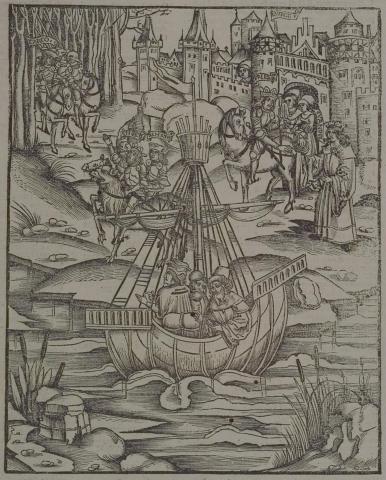Annotations
Aeneas prepares to depart from Pallanteum. A number of Evander's men set out in a boat down the river to alert Ascanius and the Trojans of the latest development in the impending war (545-50). To the right, Evander bids a tearful farewell to his son Pallas, who is preparing to follow Aeneas into battle (558-84). Two weeping women stand by the gate. They are either the attendants who will escort Evander back into the palace (783-4) or the mothers weeping to see their sons depart from the city (592-3). A head peering out from behind the wall may also represent a distraught mother. Pallas rides on horseback away from the city toward Aeneas and Achates, who prepare to start the march toward the Latins. In the top left, Tarcho and his Etruscan forces come to join Aeneas (603-5). (Katy Purington)
Woodcut illustration from the “Strasbourg Vergil,” edited by Sebastian Brant: Publii Virgilii Maronis Opera cum quinque vulgatis commentariis expolitissimisque figuris atque imaginibus nuper per Sebastianum Brant superadditis (Strasbourg: Johannis Grieninger, 1502), fol. 324r, executed by an anonymous engraver under the direction of Brant.


Sebastian Brant (1458-1521) was a humanist scholar of many competencies. Trained in classics and law at the University of Basel, Brant later lectured in jurisprudence there and practiced law in his native city of Strasbourg. While his satirical poem Das Narrenschiff won him considerable standing as a writer, his role in the transmission of Virgil to the Renaissance was at least as important. In 1502 he and Strasbourg printer Johannes Grüninger produced a major edition of Virgil’s works, along with Donatus’ Life and the commentaries of Servius, Landino, and Calderini, with more than two hundred woodcut illustrations. (Annabel Patterson)